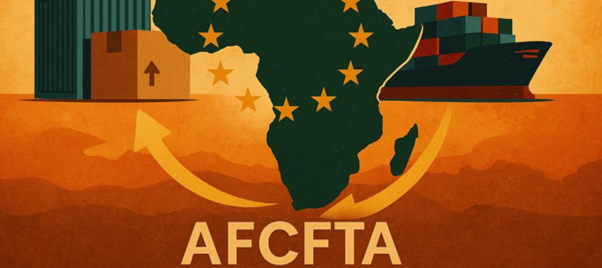Opinion : AfCFTA Is More Than Trade — It’s Africa’s Credit Shield
In this opinion piece, Sidney Essendi argues that the AfCFTA is far more than a trade framework — it is Africa’s emerging financial shield. By strengthening regional integration, shared financial infrastructure and monetary sovereignty, he makes the case that Africa’s creditworthiness depends on acting as one continental market.

By Sidney Essendi *

Africa operates like 54 solo artists competing for the world’s attention — but global capital rewards orchestras. While individual African nations struggle for favorable credit terms, scrambling for ratings upgrades that rarely come, the continent’s collective economic weight tells a different story. The African Continental Free Trade Area (AfCFTA) isn’t just reshaping commerce; it’s architecting Africa’s financial defense system.
The numbers paint a compelling picture. AfCFTA creates a unified market worth $3.4 trillion — suddenly, Africa isn’t 54 small markets but one massive economic zone. UNECA projections show intra-African trade could surge by 52% by 2035, fundamentally altering the continent’s economic gravity. But here’s what credit analysts miss: every percentage point of intra-African trade is a percentage point less dependency on volatile foreign exchange markets.
Regional payment systems like the Pan-African Payment and Settlement System (PAPSS) aren’t just technical infrastructure — they’re sovereignty tools. When Nigerian businesses can settle with Kenyan suppliers in local currencies, both nations preserve precious foreign reserves. Trade integration equals credit resilience.
The Architecture of Collective Strength
AfCFTA’s true power lies in four interconnected pillars:
Regional value chains transform raw material exporters into industrial partners. When Ghana’s cocoa feeds Ivory Coast’s processing plants, which supply South Africa’s confectionery industry, credit risk disperses across borders rather than concentrating in commodity price swings.
Shared financial infrastructure creates liquidity pools that individual nations could never achieve. The African Export-Import Bank’s expanding trade finance facilities demonstrate how continental institutions can offer terms that bypass punitive international rates.
Local currency settlement mechanisms reduce the dollar stranglehold. Every transaction settled in African currencies strengthens monetary sovereignty and reduces exposure to Fed policy shifts that have nothing to do with African economic fundamentals.
Africa-wide capital markets are emerging through cross-listings and regional exchanges. When a Rwandan pension fund can easily invest in Egyptian infrastructure bonds, capital stays on the continent, building internal financial buffers.
This integration architecture boosts creditworthiness through three mechanisms: larger unified markets signal lower default risk to international lenders; improved regional liquidity strengthens currency stability; and shared economic buffers reduce individual country volatility.
The risks are real but surmountable. Political fragmentation remains AfCFTA’s Achilles heel — trade agreements mean nothing if borders close during disputes. Infrastructure gaps create practical barriers that tariff reductions can’t solve; moving goods from Lagos to Nairobi still costs more than shipping to London. Non-tariff barriers persist through bureaucratic resistance, with some countries creating new obstacles as fast as others remove them.
Yet the opportunities dwarf these challenges. African credit rating harmonization could emerge, with regional agencies providing assessments that understand African contexts better than distant evaluators in New York or London. Regional industrialization accelerates as companies plan for continental, not national, scale. Youth SME empowerment explodes when a startup in Kigali can access customers in Cairo as easily as those in Kampala.
AfCFTA isn’t just a trade agreement — it’s Africa’s economic defense pact against external shocks.
Three strategic truths emerge from AfCFTA’s evolution:
Regional cooperation reduces vulnerability. When the 2008 financial crisis hit, African countries that traded more with each other weathered the storm better than those dependent on Western markets. AfCFTA institutionalizes this buffer.
Africa must trade more with itself to finance itself. Every dollar of intra-African trade reduces the need for dollar-denominated external debt. The equation is simple: internal commerce equals external leverage.
AfCFTA is the backbone of African financial sovereignty. Credit ratings, interest rates, and investment flows all improve when Africa negotiates as one rather than 54.
The path forward isn’t about choosing between global integration and African solidarity — it’s about using regional strength to secure better global terms. When African nations stand together, international capital must offer competitive rates. When African markets integrate, credit agencies must acknowledge reduced risk.
« Trade is the mother. Credit is the child. AfCFTA is the home. »
Africa’s economic future isn’t about hoping for better treatment from international financial systems — it’s about building systems that make that treatment irrelevant. AfCFTA is the architecture of that independence.
*Sidney Essendi is a strategist in digital transformation and African-built financial infrastructure. He is the founder of Sidnet Limited and the voice behind AfronomicsFeed, a platform focused on African economic insights.






